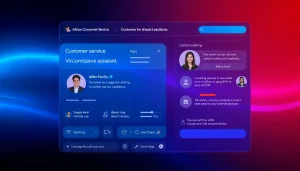Mastering PHP Web Development Course: Comprehensive Guide for Aspiring Developers
Introduction to PHP Web Development Course
In today’s digital landscape, a robust understanding of web development is not merely an advantage—it’s a necessity. PHP, a server-side scripting language, remains a cornerstone of web development. Through the PHP web development course, aspiring developers will gain practical skills, allowing them to create dynamic and interactive websites.
What is PHP?
PHP, short for “Hypertext Preprocessor,” is an open-source server-side scripting language extensively used for web development. It allows developers to create dynamic content that interacts with databases. PHP differs from client-side languages like JavaScript because it runs on the server, generating HTML that gets sent to the client’s browser, providing functionality like form submissions, user authentication, and database management.
Importance of PHP in Web Development
PHP is crucial to modern web development for several reasons:
- Wide Adoption: Used by millions of websites, including major platforms like WordPress, PHP powers a significant portion of the internet.
- Open Source: Being free to use and distribute encourages a large community of developers to contribute to its continuous improvement.
- Integration with Databases: PHP seamlessly interacts with various database systems, particularly MySQL, facilitating data-driven applications.
- Robust Frameworks: PHP boasts several frameworks, such as Laravel and Symfony, which streamline the development process and promote best practices.
Course Objectives and Outcomes
This PHP web development course aims to equip students with the following outcomes:
- Understanding core PHP concepts and syntax.
- Ability to build dynamic web applications connecting to databases.
- Implementation of user authentication and secure data handling.
- Knowledge of advanced PHP techniques, including object-oriented programming.
- Experience in completing a capstone project that showcases their skills.
Core Concepts of PHP
Data Types and Variables in PHP
In PHP, understanding data types is foundational. The language supports several built-in data types:
- Integers: Whole numbers, positive or negative.
- Floats: Decimal numbers.
- Strings: Sequences of characters, which can include letters, numbers, and symbols.
- Booleans: Represents two possible states: true or false.
- Arrays: Collections of values that can be indexed.
- Objects: Instances of classes that encapsulate state and behavior.
- NULL: A variable with no value assigned.
Variables in PHP are indicated by a dollar sign ($) followed by the variable name. Variables can be defined using the assignment operator (=) and do not require explicit declarations of data types, enhancing flexibility.
Control Structures: Loops and Conditional Statements
Control structures dictate the flow of execution in PHP. This includes:
- Conditional Statements: ‘if’, ‘else’, and ‘switch’ statements allow for decision-making based on conditions.
- Loops: ‘for’, ‘while’, and ‘foreach’ loops enable repetitive execution of code blocks, depending on the state of specific conditions.
These structures play a crucial role in creating dynamic functionality within applications, allowing for real-time data feedback and user interaction.
Functions and Scope in PHP
Functions are reusable blocks of code in PHP, promoting modular programming. They can accept parameters, enabling data manipulation within a defined context. PHP has built-in functions for mathematical operations, string processing, and array handling. Additionally, developers can create custom functions, enhancing readability and maintainability.
The concept of scope is essential in understanding where variables can be accessed within code. PHP has three primary scopes:
- Global: Variables declared outside functions can be accessed globally by using the global keyword inside functions.
- Local: Variables declared within a function are only accessible within that function.
- Static: Variables can retain their value across function calls using the ‘static’ keyword.
Building Dynamic Websites with PHP
Connecting PHP to MySQL Databases
The integration of PHP with MySQL forms the backbone of many web applications. MySQL provides a structured way to store, retrieve, and manipulate data. This section highlights how PHP interacts with MySQL:
- Database Connection: Establish a connection using the mysqli_connect() function, including parameters for the hostname, username, password, and database name.
- Executing Queries: Use the mysqli_query() function to execute SQL statements such as SELECT, INSERT, UPDATE, and DELETE.
- Fetching Data: Utilize functions like mysqli_fetch_assoc() and mysqli_fetch_array() to retrieve results from executed queries.
Understanding these interactions is essential for building data-driven applications and web services.
Implementing User Authentication
User authentication ensures that only authorized users can access specific parts of an application. PHP provides several techniques to create secure login systems:
- Secure Password Storage: Use password_hash() and password_verify() functions for hashing and verifying passwords, ensuring that user credentials are stored safely.
- Session Management: Utilize PHP sessions to track user logins and maintain state across page requests.
- Access Control: Implement role-based access control to restrict content based on user roles (e.g., admin, user).
Incorporating these measures not only enhances security but also builds trust with users by protecting their personal information.
Handling Form Data Securely
Forms are integral to user interaction on websites. However, they also present security risks. In PHP, securely handling form data involves several best practices:
- Input Validation: Ensure all incoming data is validated to prevent SQL injections and XSS attacks. Use PHP filters to sanitize inputs.
- Prepared Statements: Employ prepared statements when executing SQL queries to mitigate the risk of SQL injections.
- CSRF Protection: Implement CSRF tokens in forms to prevent cross-site request forgery attacks.
These practices are essential for safeguarding applications and user data against malicious attacks.
Advanced PHP Techniques
Object-Oriented Programming in PHP
Object-oriented programming (OOP) is a programming paradigm based on the concept of “objects,” which can contain data and code:
- Classes and Objects: A class defines a blueprint for objects; objects are instances of classes that encapsulate properties (attributes) and methods (functions).
- Inheritance: Allows a class to inherit properties and methods from another class, promoting code reusability.
- Polymorphism: Enables methods to do different things based on the object calling them, enhancing flexibility.
OOP principles in PHP facilitate code organization, making it easier to understand and maintain complex applications.
Using PHP Frameworks for Development
PHP frameworks provide a structured environment for development, offering pre-built modules and libraries to streamline the coding process. Popular frameworks include:
- Laravel: Known for its elegant syntax, Laravel simplifies complex tasks, such as routing and authentication.
- Symfony: A highly flexible framework ideal for large-scale applications, with reusable components enhancing efficiency.
- CodeIgniter: Lightweight and straightforward, CodeIgniter is perfect for those new to PHP and quick projects.
Leveraging frameworks allows developers to focus on application logic rather than repetitive code, speeding up the development process and ensuring higher security standards.
Debugging and Error Handling Best Practices
Effective debugging and error handling are crucial skills for any developer. PHP offers several methods:
- Error Reporting: Use error_reporting() and ini_set() to manage the visibility of errors during development.
- Exception Handling: Utilize try-catch blocks to handle exceptions gracefully, preventing application crashes.
- Logging: Implement logging mechanisms to keep track of errors and problematic behaviors in applications.
These practices not only improve code reliability but also enhance the overall user experience by reducing application downtimes.
Capstone Project: Real-world Application
Project Overview and Planning
The capstone project is a practical application of the skills learned throughout the course. Participants will conceptualize and plan a project that addresses a real-world problem or need, including defining objectives, identifying target audiences, and outlining essential features. This project empowers students to consolidate their knowledge while showcasing their capabilities.
Building and Testing the Application
During this phase, students will implement the project by utilizing all the core PHP concepts and practices learned. Key elements include:
- Development: Building the application, integrating front-end technologies, and ensuring back-end processes function seamlessly.
- Testing: Conducting unit tests, integration tests, and user acceptance testing to identify and fix bugs.
- Deployment: Launching the application on a live server, ensuring all aspects function correctly in a production environment.
Presenting Your Work and Feedback
The final step involves presenting the project to peers or instructors, showcasing the work done and the learning achieved. Participants will receive constructive feedback, which is invaluable for personal and professional growth. This presentation not only emphasizes the importance of communication in development but also prepares students for real-world scenarios where they need to explain their work to stakeholders.













Post Comment